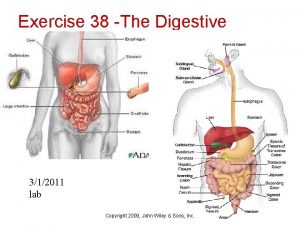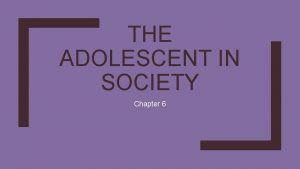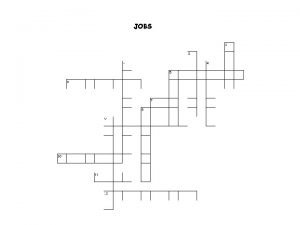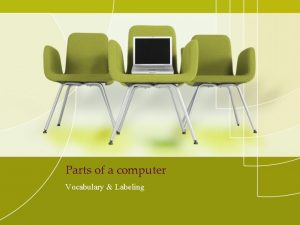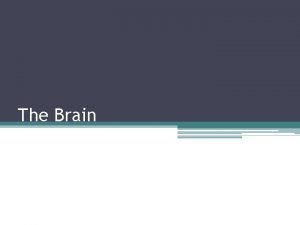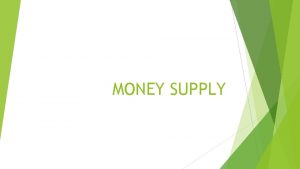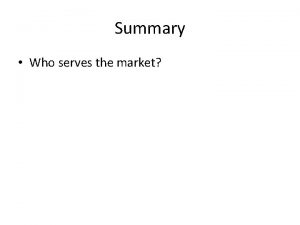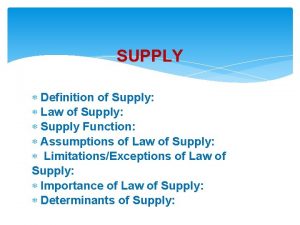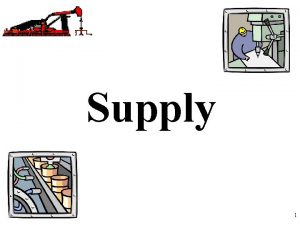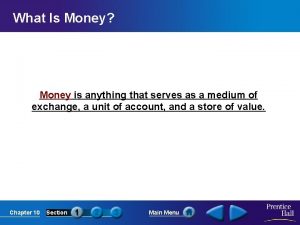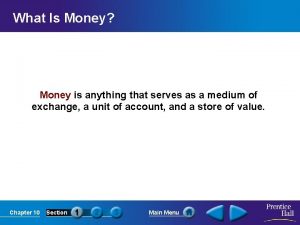Money and Money Supply Money serves a purpose










- Slides: 10

Money and Money Supply

Money serves a purpose �Money is anything accepted as final payment for goods and services �It is used for �Medium of exchange �Unit of account �Store of value

Money Supply �Currency(coins and paper money ) in the hands of the public , plus checking-type accounts. � 48% is currency � 52% checking accounts �Supply is important for price stability and economic growth

Money Supply �Too much can cause inflation. Germany after WWI saw prices increase 5, 470%. We have seen 20% in some goods this year. �Too little can lead to falling prices and production. In US between 1929 and 1933 prices fell 30%. �The Federal Reserve controls the money supply through monetary policy. Monetary policy works through encouraging or discouraging banks from making loans

Federal Reserve System �The Fed was created in 1914 after a series of bank failures. �The Fed Board of Governors � 7 members appointed by the President with Senate confirmation �Board members serve 14 -year terms. �President appoints the chairperson to a 4 -year term. Right now it is Ben S. Bernanke

Federal Reserve System � 12 Regional Federal Reserve Banks �Regional banks are located in major cities around the country �Each bank has a president chosen by the bank’s board of directors �The board of directors is typically drawn from the local business and banking community.

The Fed and Monetary Policy �Changes in the money supply, intended to maintain stable prices, full employment, and economic growth �If the Fed is fighting unemployment and declining GDP, it wants to increase the money supply. (right now it is) �If the Fed is fighting inflation, it wants to decrease the money supply.

Open market operations �The Fed buys or sells U. S. government securities to influence the money supply �The Fed sells securities, bank deposits increase, banks have more money to lend and the money supply increases �The Fed buys securities, bank deposits decrease, banks have less money to lend, and the money supply decreases.

Changes in Discount Rate �The discount rate is the interest rate that the Fed charge on loans to banks �When the Fed lowers the discount rate, banks are encouraged to make more loans and the money supply increases �The Fed raises the discount rate, banks are discouraged from making loans and the money supply decreases

Changes in the Reserve Requirement �The reserve requirement is the minimum percentage of deposits that banks must keep on reserve to back up checking-type accounts. �When the Fed lowers the reserve requirement, banks have more money to lend and the money supply increases �When the Fed raises the reserve requirement, banks have less money to lend and the money supply goes down
 Dana damian
Dana damian Exercise 38 review sheet art-labeling activity 1 (1 of 2)
Exercise 38 review sheet art-labeling activity 1 (1 of 2) Chapter 5 section 1 supply and the law of supply
Chapter 5 section 1 supply and the law of supply Matching supply and demand in supply chain
Matching supply and demand in supply chain Undefined status adolescence
Undefined status adolescence He serves in a restaurant
He serves in a restaurant Dating patterns since the 1960s are
Dating patterns since the 1960s are Chapter 16 haircutting worksheet answers
Chapter 16 haircutting worksheet answers Undefined status adolescence
Undefined status adolescence A mechanism that spins reads and writes disks
A mechanism that spins reads and writes disks Which part of the neuron serves as the protective coating?
Which part of the neuron serves as the protective coating?

